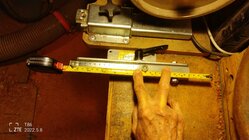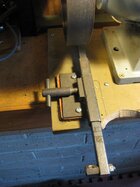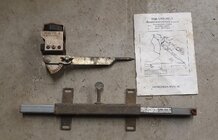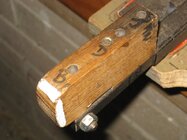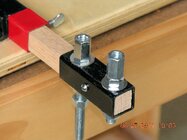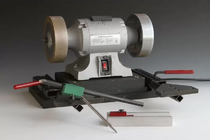I recently had a minor accident with my low speed (1750 rpm) grinder. I was using a 350 grit CBN coated aluminum wheel with my vari-grind jig. When I rolled the tool over to the left to touch up the fingernail profile, I heard a loud bang and the next thing I know my left hand was bleeding, my thumb was smashed and the jig was on the floor still holding the gouge.
When I went back to determine what happened, I found the leg angle on the vari-grind had reset from 23 degrees to zero and the gouge was no longer projecting 2 inches from the front of the jig. There was a dig in the wheel that appears to be caused by the left edge of the gouge digging into the wheel (see photo). Portions of the vari-grind that should never come in contact with the wheel also had some deep scratches.
The particular gouge I was sharpening was made of ASP 2060 steel which may be harder than most currently available gouges.
Does anybody know of a similar incident? I have never heard of anybody getting a dig in an aluminum oxide wheel. I'm interested in comments.
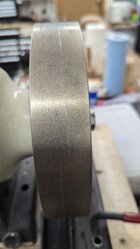 I have more photos and details if anybody is interested. I asked the vendor who sold me the CBN wheel if they wanted it back or more information from me but have not heard back.
I have more photos and details if anybody is interested. I asked the vendor who sold me the CBN wheel if they wanted it back or more information from me but have not heard back.
When I went back to determine what happened, I found the leg angle on the vari-grind had reset from 23 degrees to zero and the gouge was no longer projecting 2 inches from the front of the jig. There was a dig in the wheel that appears to be caused by the left edge of the gouge digging into the wheel (see photo). Portions of the vari-grind that should never come in contact with the wheel also had some deep scratches.
The particular gouge I was sharpening was made of ASP 2060 steel which may be harder than most currently available gouges.
Does anybody know of a similar incident? I have never heard of anybody getting a dig in an aluminum oxide wheel. I'm interested in comments.
 I have more photos and details if anybody is interested. I asked the vendor who sold me the CBN wheel if they wanted it back or more information from me but have not heard back.
I have more photos and details if anybody is interested. I asked the vendor who sold me the CBN wheel if they wanted it back or more information from me but have not heard back.
